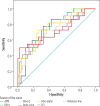Investigation of liver fibrosis with serum biochemical parameters before treatment with direct-acting antivirals, at the end of treatment, and in the first and third year after treatment in patients with chronic hepatitis C
- PMID: 37064837
- PMCID: PMC10090997
- DOI: 10.5114/ceh.2023.125917
Investigation of liver fibrosis with serum biochemical parameters before treatment with direct-acting antivirals, at the end of treatment, and in the first and third year after treatment in patients with chronic hepatitis C
Abstract
Aim of the study: In the treatment of chronic hepatitis C, the need for non-invasive methods, other than invasive methods, is increasing for the detection of fibrosis before and after treatment. In our study, we aimed to determine the changes in histological response with post-treatment biochemical scoring in patients treated with direct-acting antivirals.
Material and methods: Between June 1, 2016, and January 1, 2020, 125 patients followed up with a diagnosis of chronic hepatitis C, who presented to Haseki Training and Research Hospital, were enrolled in the study. Scores of APRI, Fibro Q, Fibrosis-4 (FIB-4) index, Doha score, Fibro alpha, and fibrosis-cirrhosis index were used to evaluate the liver fibrosis of the patients with examinations before treatment, at the end of treatment and at the 12th week, first year, and third year after treatment. The study was conducted as a retrospective observational case series.
Results: One hundred twenty-five patients were enrolled in the study. The mean age was 55.5 ±15.9 years. Patients were divided into two groups according to their baseline FIB-4 values: cirrhotic/noncirrhotic. Seven (5.6%) patients had compensated cirrhosis; there were no decompensated cirrhotic patients. There was a statistically significant decrease in scores of APRI, FIB-4, Fibro Q, and Doha score calculated during the end-of-treatment three-year follow-up period.
Conclusions: It was shown that serum fibrosis scores, such as APRI, FIB-4, Fibro Q, and Doha score, could be used to detect fibrosis before treatment and to follow histological improvement after treatment with direct-acting antivirals (DAA) in chronic hepatitis C patients.
Keywords: chronic hepatitis C; fibrosis; noninvasive tests.
Copyright © 2023 Clinical and Experimental Hepatology.
Conflict of interest statement
The authors declare no conflict of interest.
Figures
Similar articles
-
Fibrosis scores that can be used in follow-up of after direct-acting antiviral treatment: APRI, FIB-4, King score and GUCI.Eur J Gastroenterol Hepatol. 2022 Mar 1;34(3):308-315. doi: 10.1097/MEG.0000000000002204. Eur J Gastroenterol Hepatol. 2022. PMID: 34091480
-
Gadolinium-ethoxybenzyl-diethylenetriamine penta-acetic acid-enhanced magnetic resonance imaging for evaluating fibrosis regression in chronic hepatitis C patients after direct-acting antiviral.World J Gastroenterol. 2022 May 28;28(20):2214-2226. doi: 10.3748/wjg.v28.i20.2214. World J Gastroenterol. 2022. PMID: 35721884 Free PMC article.
-
Noninvasive Measurements Predict Liver Fibrosis Well in Hepatitis C Virus Patients After Direct-Acting Antiviral Therapy.Dig Dis Sci. 2020 May;65(5):1491-1500. doi: 10.1007/s10620-019-05886-y. Epub 2019 Oct 25. Dig Dis Sci. 2020. PMID: 31654313
-
Changes in APRI and FIB-4 in HBeAg-negative treatment-naive chronic hepatitis B patients with significant liver histological lesions receiving 5-year entecavir therapy.Clin Exp Med. 2019 Aug;19(3):309-320. doi: 10.1007/s10238-019-00560-z. Epub 2019 May 20. Clin Exp Med. 2019. PMID: 31111345
-
Hepatic fibrosis changes in patients with chronic hepatitis C infection who respond to direct-acting antivirals.Ann Saudi Med. 2022 Mar-Apr;42(2):89-95. doi: 10.5144/0256-4947.2022.89. Epub 2022 Apr 7. Ann Saudi Med. 2022. PMID: 35380056 Free PMC article.
References
-
- El-Kamary SS, Kottilil S. Viral hepatitis. In: Ryan ET. Hunter’s Tropical Medicine and Emerging Infectious Diseases, 10th edition. 2020; 35:308-324.
-
- World Health Organisation, News room, fact sheets, cancer. In: WHO [Internet]. 21 September 2021. http://www.who.int/news-room/fact-sheets/detail/cancer.
LinkOut - more resources
Full Text Sources
Research Materials

